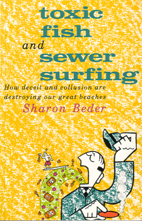
by Sharon Beder
first published by Allen & Unwin, Sydney, 1989
Introduction
Sewers seaward
Toothless watchdog
Toxic fish
Sewer-side surfing
Public relations battle
Events of 1989
Beyond Sydney
Conclusion
Bibliography
ANY ELEMENTS of the story of Sydney’s sewage problems will be familiar to people battling sewage disposal schemes in other towns. Sydney is special in that beach culture is part of its self-identity. Going to the beach is an essential part of growing up in Sydney and for people it is where they met their first girl or boy friends, where they ‘hang out’, where they relax. But Sydney is also the same as cities everywhere, facing problems of disposing of ever-increasing amounts of sewage with ever-decreasing space to do it in, and problems of where to dispose of hazardous wastes.
The players are generally the same too – the engineers who look for ‘cost-effective’ solutions that put less value on environmental amenity than the public do; the environmentalists who are faced with exposing hazards that you can’t see or touch; the regulators who are pulled in various directions by competing interest groups; and the politicians who do not want to risk unpopularity by putting up taxes and being tough on industrial waste dischargers, or by accommodating industry and failing to protect public health and the environment. Too often they try to salvage their popularity by covering things up.
Sydney’s story bears the marks of a particular balance of power between government authorities, politicians, industry and citizen groups. Elsewhere that power relationship is different but the battles are fought along similar lines. Sydney is an example for every other town in Australia faced with a proposal for an ocean outfall. It stands as a monument to the whole concept of ocean disposal. Throughout the country the battle lines are being drawn between local residents who don’t want a ‘Bondi’ outfall in their town and the engineers advising their councils that an ocean outfall is the best way to go.
The public has never really been totally convinced by the engineers’ argument, and feels that existing outfalls provide good evidence against it. All along the eastern coast of Australia – the Gold Coast, Byron Bay, Coffs Harbour, Swansea/Belmont, Tomaree Peninsula/Boulder Bay, Burwood Beach, Newcastle, Jervis Bay, East Gippsland and 13th Beach, Geelong, ocean outfalls have become a subject of controversy. A look at events in two of these places, and a further example from New Zealand, are useful to show the range of outcomes that are possible. In each controversy control of sewage decisions remained with local government rather than State or Federal governments. At Coffs Harbour an outfall is being pushed through in an ecologically sensitive area despite public opposition. At Byron Bay the engineers may yet succeed in getting an ocean outfall established despite widespread opposition to it. And in Wellington, New Zealand, it seems that the people have won better treatment for their sewage! But where do the differences lie?